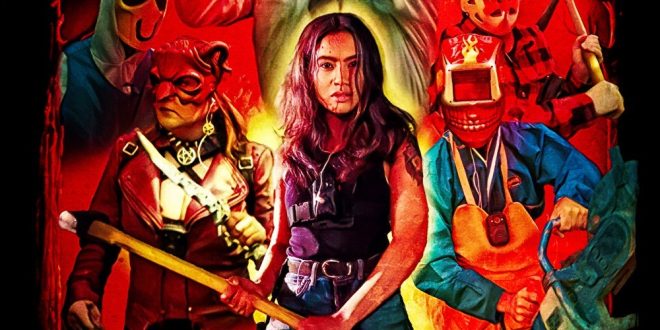Horror Facts had the chance to sit down with Lori Evans Taylor, the writer and director of the new psychological horror film Bed Rest. During our conversation, Horror Facts learned about the process that went into bringing Bed Rest to life, as well as the real-life tragic events that inspired the Tubi original film.
Horror Facts: First off, I appreciate you taking the time to speak with Horror Facts.
Lori Evans Taylor: Thank you for having me.
Horror Facts: I had the opportunity to watch Bed Rest the other day and have many questions, but first and foremost, I want to know the whole process that went into creating Bed Rest, starting with: Where did the idea come from?
Lori Evans Taylor: It has been a long time coming. The first idea came about ten years ago, so it’s been a ten-year journey. As far as the idea for the writing of the script, there were two things that happened in my life that inspired it. The first being, I had just had my daughter back in 2012 and I was at home alone a lot during that time and started getting a little cabin fever. I wasn’t going outside a lot and I started having my own little Jack Torrance moment. I was never officially on bed rest, but I started thinking about friends of mine who had been through that experience, whether it had been days, weeks, or months, and I just started thinking about what it does to you psychologically. I’ve always loved horror so, of course, my twisted mind went to, “Oh, this a great setup for a horror movie. Why hasn’t anyone done that?” So, I just kind of put that idea on the back burner and knew I wanted to get to it at some point. That was kind of the kernel of the idea. And then there was this emotional side to it, as well, because I have personally always been drawn to horror movies that have a sense of heart behind them. My husband and I, the year before – so in 2011 – we had a pregnancy and everything was going fine and then, in the eleventh hour, there was a complication and we had a stillbirth and so I was dealing with a lot of grief because you have this idea that you’re going to have a child and then suddenly it’s like the rug was ripped out from under us. So I had been working through that grief as I was working on Bed Rest and then, unintentionally, I realized that the two ideas kind of came together, and I wanted to explore that idea because grief is universal. Everybody experiences some sort of grief, but stillbirth is a very specific kind of grief in that usually when somebody passes, everybody gets together and communally mourns that person and tells stories, but with stillbirth, a lot of the responsibility is put on the mother and, to a certain extent, her partner in terms of, like, carrying on the memory of the child. I wanted to explore that emotional journey through Bed Rest and to sort of balance the concept of bed rest, and in particular, a woman on bed rest in this new house that may or may not be haunted, but then I also wanted to add in that emotional side of it, as well. So that was the basis of the script and then it kind of went from there.

Horror Facts: What was the process of bringing your idea from the page to the screen?
Lori Evans Taylor: It took me a little while but I eventually wrote it in 2015. It was initially a spec script that went out and it was during the time that everybody was like, “Nobody buys specs. Why are you coming up with a spec?” But it ended up going out on a Tuesday and, by the Friday, everybody was excited about it. Initially, it was a preemptive deal with this major studio, which was very exciting – thinking it was going to get made – but then, like a lot of things, it just for some reason got caught in the development process in the studio and just sat on the shelf for a while. Then, eventually, when the option came up, I decided not to re-up or re-option it and instead decided that I wanted to take it back because it was such a personal project to me. You know, there are some things that you write and you’re OK if it goes out and gets caught up in the studio system, but this piece, in particular, was very personal to me and, because I had been in theatre for a long time, I knew eventually I wanted to direct films, so I had my come to Jesus moment and said, “OK, this is what I’m going to do. I’m going to go out on a limb and I’m going to try and get this made,” and then luckily, Project X came on board and supported me. I love those guys over there because I have known them forever and they championed me as a director. So it was a cool experience.

Horror Facts: That’s what makes horror good: it’s never just horror; there’s always that underlying story. And from watching your film, that’s what made your movie so effective: because it had that underlying story about loss.
Lori Evans Taylor: Thank you. That’s why I have always loved horror. Ever since I was a kid, I have always gravitated toward horror. It’s been a really important part of my life, and as you said, it kind of tricks you. That’s the beauty of horror movies: you get an audience to come in and, yes, be scared and thrilled, but in a lot of great horrors, especially in the last ten years, there’s been this real horror renaissance that’s been leaning into metaphors and getting at things that you can’t always get at through straight drama. I think it’s a really exciting platform in a way to tell stories.
Horror Facts: Talking about underlying stories in horror, it felt like the house itself was written to add an element of emotion to the story. Here you have this couple who move into the house and are immediately faced with numerous issues related to the house. That’s every homeowner’s real-life horror story right there.
Lori Evans Taylor: Right. That’s usually the nightmare. You move into a new home and suddenly the plumbing doesn’t work. But that is one of the reasons I love working with Melissa. Not only do I love working with her as an actress because she’s incredibly smart and talented, but that’s one of the things that we were talking about when we were originally talking about the character. It was always in the script that the house would be plagued with problems. In one of the previous versions, it was such a drain on the Julie character, but Rachael was like, “Wait. What if this is what Julie loves? Getting in and fixing old things and that’s what inspired her job with antiques.” I love that spin where, for most of us, that would be such a slog to redo an old house but for Julie, she’s excited about it because she likes to fix broken things. But that would be my nightmare, having to redo a house that I just moved into.

Horror Facts: What made Bed Rest unique is that it has never been told from this perspective before. Here you have a character that is stuck on bed rest and can’t even get up to get a pen. This made for a very claustrophobic story.
Lori Evans Taylor: Yes. I’m hoping since we’ve all gone through COVID and, to a certain extent, we’ve all done this where we were out there living our lives and then, when COVID happened, everyone’s lives just stopped and they were stuck in rooms. I think we all can understand what that means to have those things that emotionally start to bubble back up when you can’t leave and when you can’t just go hang out with other people. Hopefully Bed Rest is very timely in that way.
Horror Facts: One thing that I liked about the movie is that you were able to completely trick the viewer and throw so many red herrings at us on at least two separate occasions in the film. The first is when the child is introduced. I, as the audience member, immediately guessed that the spirit had to be her late child, and then when the kid acknowledges it in the film, you get this sensation like you got one over on the filmmaker for guessing the twist. But then, later in the movie, you were like, wait, you’re wrong; it’s this. So as the viewer, you’re thrown for this unexpected twist. The same thing happens again later in the movie when the kid claims she’s “trying to get little sister” and you immediately think it’s the Delmy character, just like Julie does. So once again, you’re lulled into this sense of false pride for predicting it, but then, again, you throw a curve ball at us. As the audience member, I felt like I didn’t predict anything because all my predictions proved to be wrong.
Lori Evans Taylor: Oh, good! I’m glad because that’s the fun of the experience, because everything is from her point of view, so we’re trying to figure it out with her and she can only hear so much and see so much and that’s where the Hitchcockian part of it all comes into play. So, I’m glad that you had that experience; that makes me happy.
Spoiler Alert.
Horror Facts: I know you said you were inspired by your personal experiences when you wrote the script, but watching the film, I picked up a hint of the legend of La Llorona. Was that intentional or was I reading something into it that wasn’t there?
Lori Evans Taylor: The ghost in the house is indeed a mother who lost her unborn child and then, sadly, drowned her children in the tub. But what’s interesting is that it was a year or two after I had written the original spec script that I found out about La Llorona. I had never heard of that before, so there was never any direct influence but there are certainly parallels, for sure. I think, at the time, there had sadly been a bunch of stories in the news where women had gone through postpartum depression issues and hurt their children. These children that they had always wanted but, because of the postpartum, the depression, or the psychosis, had done these horrible things. That was on my mind because I wanted to look into this idea of motherhood and loss and grief and how that can affect somebody.

Horror Facts: Building on the concept of questioning if Julie is insane, watching Bed Rest, I liked how you threw in the footprints on the ceiling and the eyes in the closet, because you keep drawing us in where we, as the audience, are forced to continually question everything that’s going on. We have to keep asking ourselves if she is insane. Is she hearing the giggling? Is that child made up or is it all in her head?
Lori Evans Taylor: That’s ideally what that experience is playing on, that “is she going insane?” realm. Is she seeing these things? And, as you start to go through this movie, you start to realize that she has these past mental health issues so, wait, are we dealing with an unreliable narrator? That was the fun of the experience: playing in that murky world of, wait, are we rooting for somebody who’s losing their mind or is there something truthful going on here? I love movies like that. Those great psychological movies that keep you guessing until the end.
Horror Facts: It felt like, in the last half an hour of the film, you decided to switch gears and bring the horror.
Lori Evans Taylor: Yeah, I was trying to reward all the people who were waiting for the big punch. It was a “you get to have your cake and eat it, too” moment, where you got to enjoy the psychological journey, but now you also get the rewarding physical journey. It’s here where we learn it was all true and we can begin to root for our character.

Horror Facts: How can people see Bed Rest?
Lori Evans Taylor: Bed Rest releases exclusively on Tubi in the United States on December 07 and then theatrically internationally. I’m excited for people to see it. It’s been a labor of love, no pun intended, but I’m just really excited for people to see it.
We at Horror Facts would like to personally thank Lori Evans Taylor once again for taking the time to speak with us about Bed Rest.
You can see Bed Rest exclusively on Tubi by clicking on the above link, or by going to TubiTv.com.
If you liked this interview you should check out what we thought about the film.

I have come here to chew bubblegum and write horror, and I’m all out of bubblegum.
Senior Editor at Horror Facts
















































































:quality(85):upscale()/2020/12/16/908/n/1922564/fc3248845fda72672054e8.54647460_.jpg)


